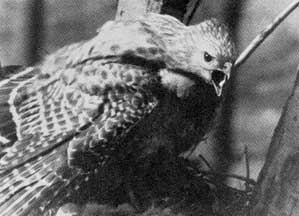Red Shoulders and the Camera's Eye
By ALFRED M. BAILEY
Nature Magazine, March 1932
The majority of the birds of prey nest early in the spring. One of the common species of North America is the red-shouldered hawk, Buteo lineatus lineatus, which builds its homes from the Atlantic to the Great Plains and from Florida to Maine. The northern breeding birds arrive in March when the woods are brown and bare of vegetation. Soon after, they begin to work on their abodes, and although they do not use the same site with the, regularity of eagles, it is not uncommon for a pair of red-shouldered hawks to use the same crotch for several successive years. The nests are rather bulky platforms of sticks and twigs, lined with the bark of trees.
It was a cold day in March that we were plodding through the forest preserves of Cook County, Illinois, in the hope of seeing a few new arrivals from the south. The wind was chill and the skies were gray, while the dead leaves were moist underfoot. As we climbed a steep wooded knoll, a dark colored bird flushed from a nest high in the branches of an ash, and winging among the gray trees, disappeared in the distance.

THE MOTHER SHRIEKS IN DEFIANCE
We had been making motion films for the Chicago Academy of Sciences and were desirous of adding a bird of prey to our series. Here was a wonderful opportunity. The hawk's nest was sixty feet in the air, but it was ideally located for photographing, for there was a tree twelve feet to the east in which we could build a blind. On April 4 we visited the site and attempted to erect a platform in the neighboring tree, but the long climb without branches was too much for our unused muscles. We did inspect the home, however, and found three eggs in the cuplike depression of the bark-lined platform.
Two days later we returned, armed with climbing irons and material with which to build a blind. A little platform was quilt and a small piece of canvas hung in place, so the old bird would have an opportunity to get accustomed to it before the rest of the shelter was completed. The camera lens was ten and one half feet from the center of the nest!
On the second week in April we again visited our hawk. The brooding bird was at home, but she flushed before we were within a hundred yards. We completed the blind and made motion films showing the barren woods of early April, and from the nesting tree I made studies of four beautifully marked, brown-splotched eggs.
Owing to the position of the blind, it was necessary to make all the photographs early in the morning. It was not until April 18 that I was able to return to photograph, and the day was overcast, with threatening rain clouds hovering low over the spring woods. I climbed the tree to my swaying perch, and then dropped a line; a friend made my motion camera fast so I could draw it to the aerial platform.
I entered the blind at 7:20 a. m. There was scarcely a sound to be heard. In the distance I could occasionally hear the high-pitched challenge of one of the hawks, but the forest itself was strangely devoid of life.
 Printer-friendly version
Printer-friendly version
